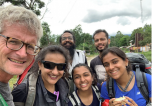In 2013, National Geographic explorer Paul Salopek set out on a journey around the world — walking the path the first humans traveled beginning 60,000 years ago. His plan had been to cover the 21,000 miles in seven years. He’s walked more than 9,000 miles, which means Salopek is behind schedule. But that doesn’t bother him. He likes to take his time so he can practice “slow journalism” — seeing, listening and experiencing new things.
“The world is way too interesting a place to pass through without pausing often, to listen and to learn. So I stop a lot more than I first imagined,” he says. A six-hour walk to reach a place seems “utterly normal.”
Salopek, 57, says he’s never bored:
• He tries new food wherever he goes — munching on leaves he’s plucked from trees in a rainforest.
• He’s learned traditional medicine practices — treating leech bites with a flower. (A leech is a bloodsucking worm.)
• And he develops new skills. When he had to wait for the winter snow to melt in Central Asia before continuing on his journey, he studied Russian.
We asked Salopek, who is in northern Myanmar, to share more of his recent discoveries.
Tell us about one or more of the families you’ve met. How are they like American families? How are they different?
“Happy or unhappy, most families are alike. It doesn’t matter whether they are in a yurt in Kazakhstan or a glass skyscraper in Israel. Maybe the size is the only difference. North Americans tend to have small families. I’ve stayed in homes in places like Turkey or India, where there are many generations under one roof — kids, parents, grandparents, even uncles and aunts. Sharing a bed with hosts of the same gender is pretty common, simply because there’s no other space.”
How does a girl’s education compare with a boy’s?
“Girls often don’t receive the same education opportunities as boys in many places of the world that I’ve walked. This was visible especially in conservative agricultural economies. Everyone knows this is a huge loss to the societies involved. There are always remarkable exceptions, of course. I met parents along my route who were going against the grain, and valuing their daughter’s educations, and that was refreshing. The Ismailis, a minority branch of [Shiite] Muslims, have a saying: ‘If parents are so poor they must choose between educating a son or daughter, then send the girl to school first.’ They are a prosperous and relatively egalitarian community.” [That means they believe in equal rights.]
All around the world young people are sounding an alarm — warning us of the climate emergency. What role are the young people you’ve met playing?
“I’ve seen the effects of climate change from the first step of my journey back in 2013. I’ve seen fickle rains in the Horn of Africa cause violence between herders who are competing for scarce grass and water for their goats and camels. I’ve seen record rains in Kazakhstan make the steppes there impassable to travel for the first time in memory. The strange thing is that older people can see this, because they’ve been alive long enough to register the changes. But it’s mainly young people who are demanding action.”
Young people across the world are going online to find out more about Salopek’s journey. You too are invited to take part. “Join me,” Salopek says. “Follow the walk’s storytelling. And do get out and walk a bit on your own, to better understand your community.”
You too can practice slow journalism while you walk.
[Sawyer is a contributing editor at the Pulitzer Center, an educational partner of Paul Salopek and the Out of Eden Walk.]
